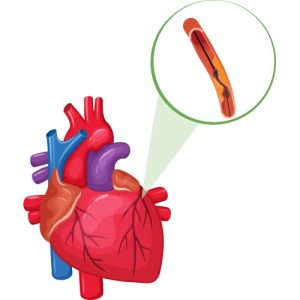What is Angiography ?
Angiography is used to check for any blockages in coronary artery. It is also known as arteriography. Angiogram is a X-ray that gives images of blood vessels in the body. In coronary Angiography a special dye(contrast material) and x-rays are used to see how the blood flows through the arteries in the heart.

Types Of Angiogram
- Coronary Angiography
- Magnetic Resonance Angiography
- Computed Tomography Angiography
- Pulmonary Angiography
Why is Coronary Angiography used?
Angiography helps to diagnose several problems related to blood vessels. It is primarily used in following situations:
Evaluation of chest pain or angina
- Coronary angiography is commonly performed when a person experiences chest pain or other symptoms suggestive of coronary artery disease (CAD).
- It helps identify the presence, location, and severity of blockages or narrowing in the coronary arteries that may be causing reduced blood flow to the heart.
Diagnosis of coronary artery disease (CAD):
- If a patient is suspected of having CAD based on symptoms, medical history, or non-invasive tests such as stress tests or electrocardiograms (ECGs), coronary angiography may be recommended to confirm the diagnosis.
- It provides a detailed assessment of the coronary arteries, allowing doctors to determine the extent and severity of any blockages.
Preoperative assessment for cardiac surgery
- Prior to certain cardiac surgeries, such as coronary artery bypass grafting (CABG), coronary angiography is performed to assess the anatomy of the coronary arteries.
- It helps surgeons plan the procedure by identifying the locations for graft placement or determining if additional interventions, such as angioplasty or stenting, are required.
Evaluation after a heart attack (myocardial infarction):
- When a person has experienced a heart attack, coronary angiography is often performed to assess the extent of damage to the heart muscle and identify the underlying cause, such as a blockage in the coronary arteries.
- This information helps guide further treatment decisions and may inform the need for interventions like angioplasty or stenting.
Monitoring of coronary artery interventions:
- If a person has undergone coronary interventions, such as angioplasty or stenting, follow-up coronary angiography may be performed to assess the success of the procedure and check for any complications or restenosis (re-narrowing) of the treated arteries.
Which Patients need Coronary Angiography?
- Suspicion of coronary artery disease (CAD): If a patient presents with symptoms suggestive of CAD, such as chest pain (angina), shortness of breath, or other symptoms related to reduced blood flow to the heart, coronary angiography may be recommended to evaluate the presence and severity of blockages in the coronary arteries.
- Abnormal non-invasive test results: If non-invasive tests, such as stress tests, electrocardiograms (ECGs), or imaging studies like myocardial perfusion scans, indicate a high likelihood of CAD or show significant abnormalities, further evaluation with coronary angiography may be warranted to obtain more detailed information.
- Acute coronary syndrome (ACS): In the context of an acute coronary syndrome, which includes conditions such as unstable angina or myocardial infarction (heart attack). coronary angiography is typically performed as an urgent or emergent procedure. It helps identify the location and severity of the blockage causing the acute event, allowing for immediate intervention if necessary.
- Prior to cardiac surgery: If a patient is scheduled for certain cardiac surgeries, such as coronary artery bypass grafting (CABG), coronary angiography is commonly performed as part of the preoperative assessment. It helps determine the extent and severity of coronary artery disease, assisting the surgical team in planning the procedure and identifying the need for additional interventions.
- Follow-up after coronary interventions: After undergoing interventions such as angioplasty or stenting to open blocked coronary arteries, patients may undergo follow-up coronary angiography to assess the effectiveness of the procedure, confirm the patency of the treated vessels, and detect any restenosis or complications.
Cardiac Angiography Procedure:
- A sedative is given before the test to relax the body.
- An area of body is numb with an anaesthetic.
- Then Cardiologist inserts a hollow tube called catheter through an artery and moves it to heart.
- Once the catheter is in correct position in heart, a dye is injected into the catheter.
- The dye helps highlight the blockages.
- X-rays are taken to see the movement of dye in the artery.
- The whole procedure takes place 40-60 minutes.




